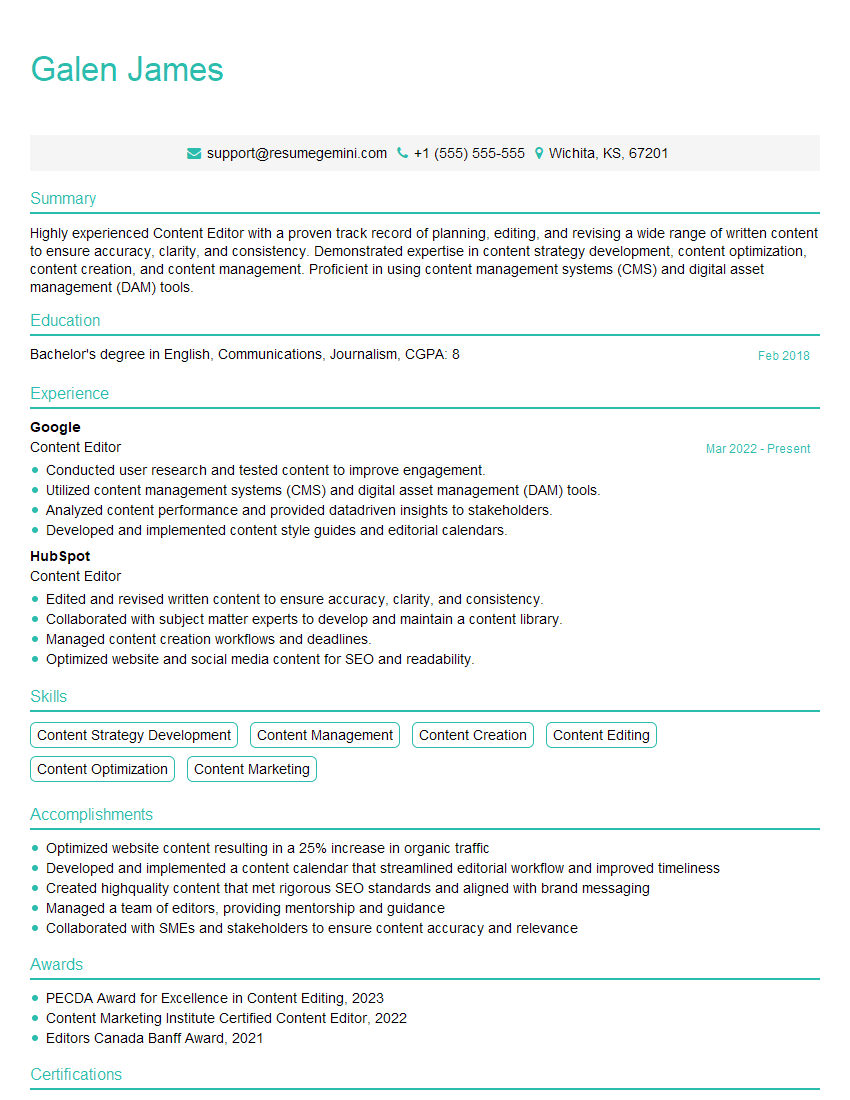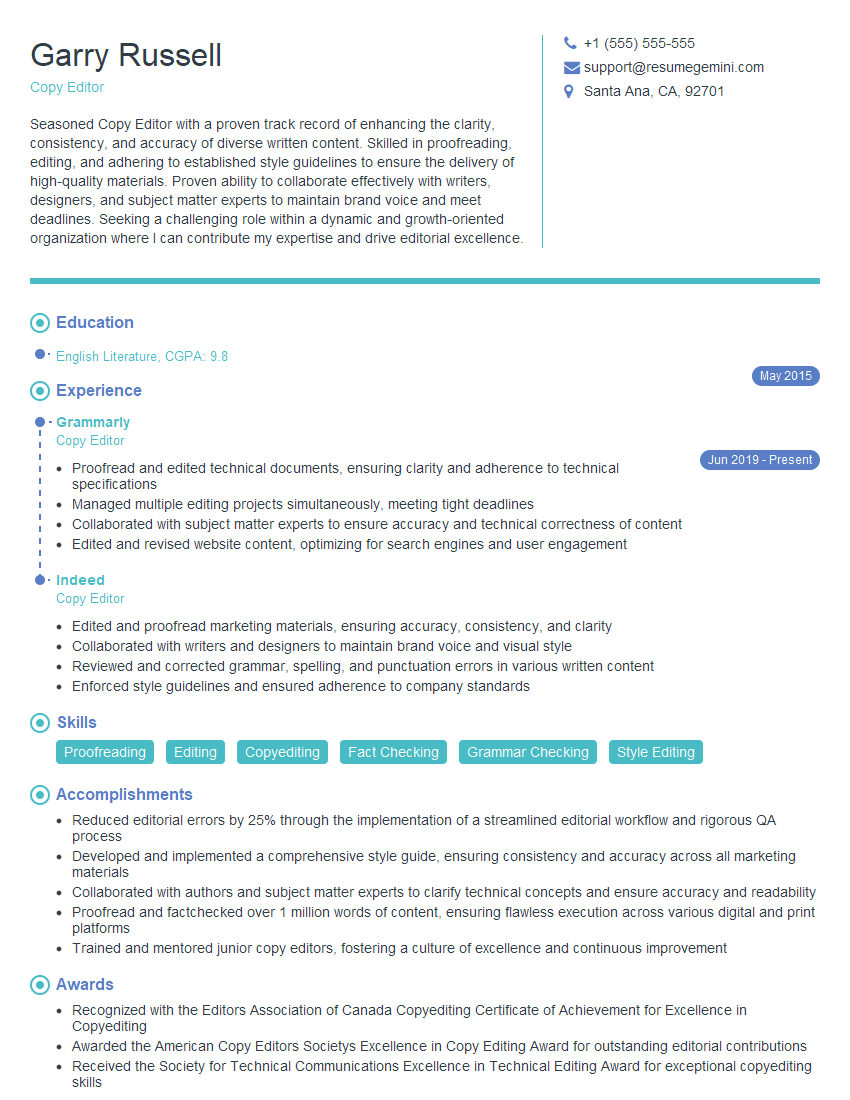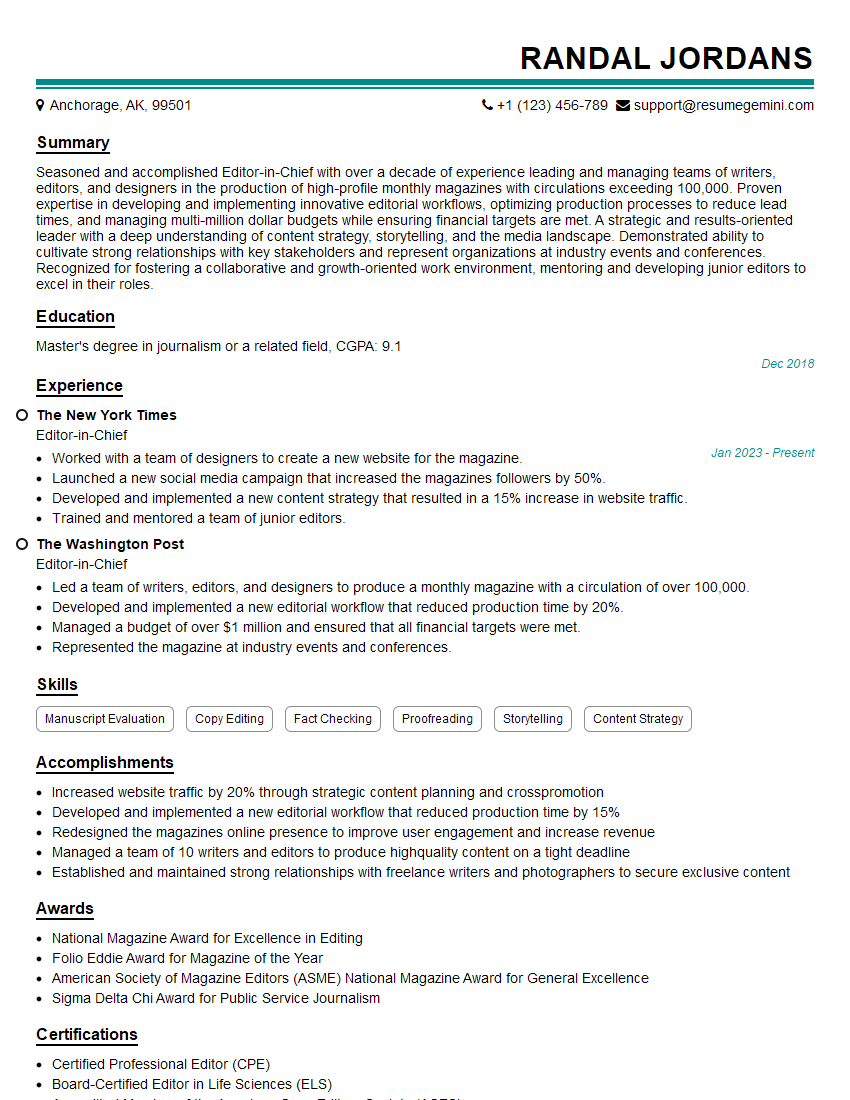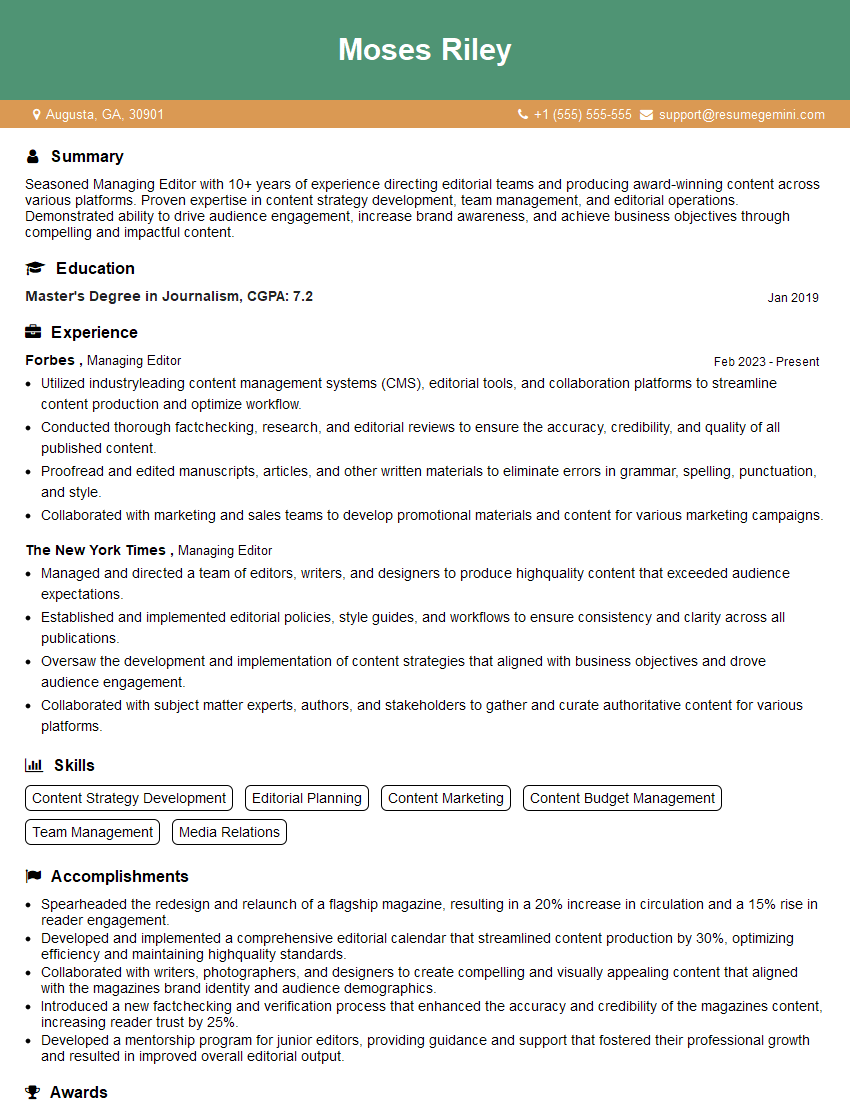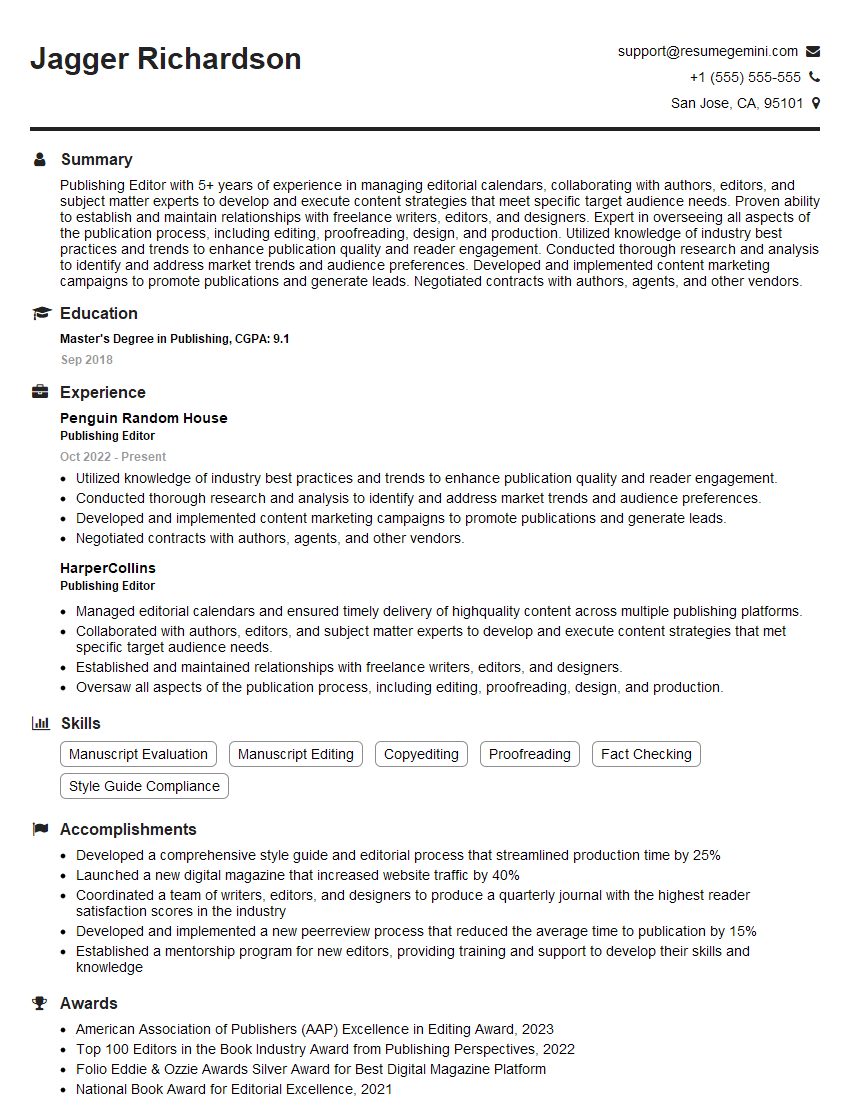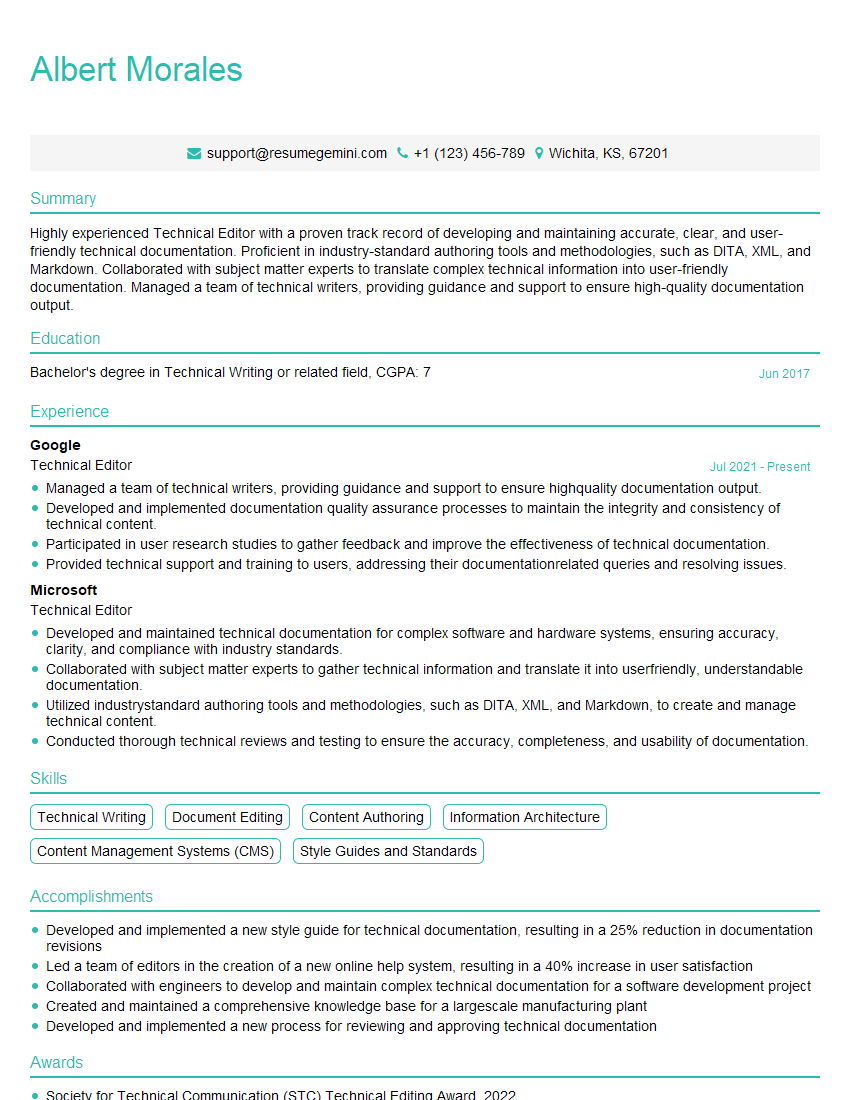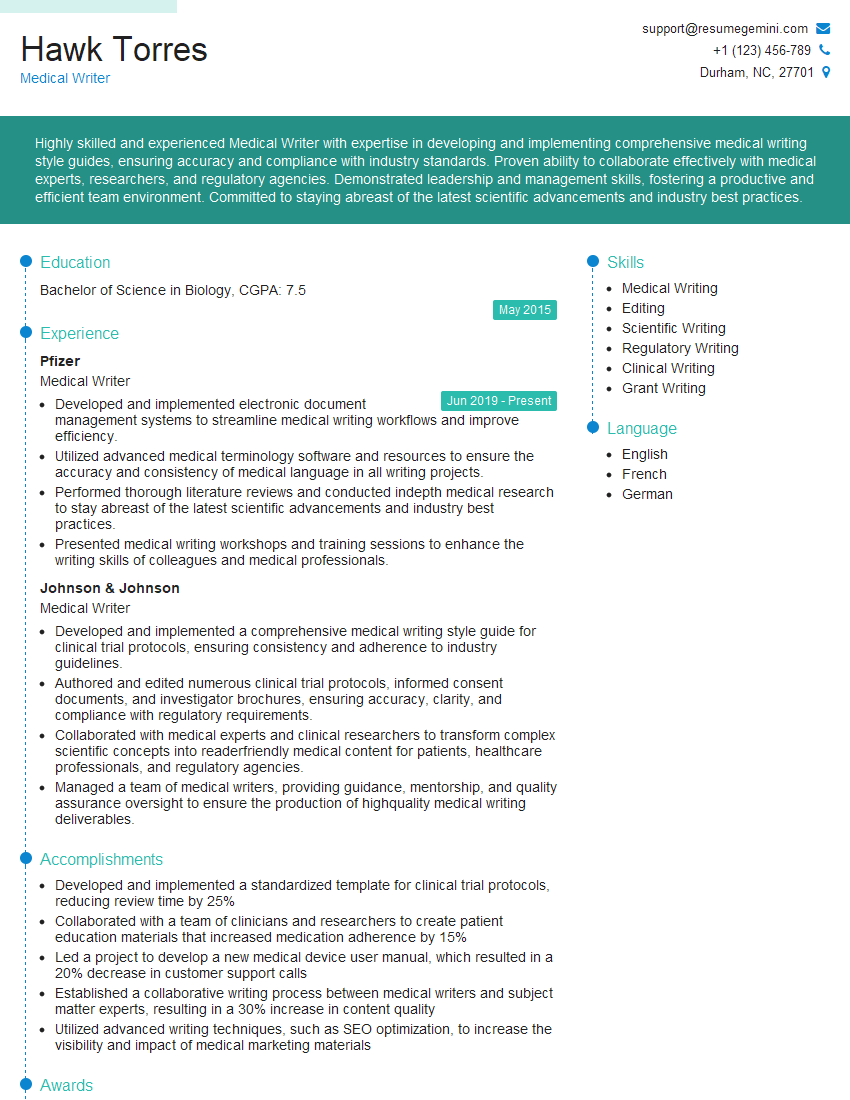Interviews are opportunities to demonstrate your expertise, and this guide is here to help you shine. Explore the essential Writing and Editing Programs interview questions that employers frequently ask, paired with strategies for crafting responses that set you apart from the competition.
Questions Asked in Writing and Editing Programs Interview
Q 1. Explain your experience with different style guides (e.g., AP, Chicago).
My experience with style guides like AP and Chicago is extensive. I understand that different publications and fields require specific formatting and stylistic choices. The AP Stylebook, for example, is crucial for journalism and focuses on brevity and clarity, often prioritizing objectivity. I’ve used it extensively in news writing and editing roles. The Chicago Manual of Style, on the other hand, is more comprehensive and is often preferred for academic publications and books. It covers a wider range of stylistic issues, including note citation and bibliography formatting. I’ve applied this in projects involving scholarly articles and book manuscripts. My proficiency lies not just in adhering to these established guidelines, but also in adapting them to the unique needs of each project. For instance, I once worked on a project that blended elements of both AP and Chicago styles to create a unique house style guide for a scientific journal.
For instance, a key difference is how they handle numbers: AP generally spells out numbers one through nine, while Chicago often spells out numbers only up to a certain point. Understanding these nuances ensures consistency and professionalism. I regularly consult both style guides and am familiar with other style guides such as MLA.
Q 2. Describe your process for editing a complex technical document.
Editing a complex technical document requires a methodical approach. My process involves several key stages. First, I thoroughly read the document to grasp its content and identify the target audience. This helps me determine the appropriate level of detail and technical language. Next, I conduct a macro-level edit, focusing on overall organization, flow, and clarity of arguments. This stage involves checking the document’s logical structure, ensuring consistent terminology, and verifying that the information is accurate and complete. Following that, I perform a micro-level edit, focusing on grammar, punctuation, spelling, and style. This involves meticulous attention to detail and consistent application of the relevant style guide. Finally, I perform a proofread, checking for any remaining errors before sending the final version back. For example, while editing a complex engineering manual, I discovered a crucial inconsistency in the use of key terms which could have caused confusion for the readers. My edits ensured that the terminology was uniform and accurate across the document. Each stage involves using various tools; from grammar and spell check to sophisticated software tools which identify inconsistencies.
Q 3. How do you identify and correct grammatical errors and inconsistencies?
Identifying and correcting grammatical errors and inconsistencies is a crucial part of my editing process. I use a multi-pronged approach. I start with a careful reading of the text, paying close attention to sentence structure, verb tense consistency, subject-verb agreement, and pronoun usage. I often use a combination of my trained eye and grammar-checking software to ensure accuracy. Software can quickly highlight potential problems but it’s important to check its suggestions carefully as it can sometimes flag correct usage as erroneous. For example, it may wrongly flag a complex sentence as incorrect. Following the initial check, I create style sheets to establish guidelines for consistent formatting of headings, lists, and other stylistic features throughout the document to maintain consistency.
Beyond the software, I rely on my understanding of grammatical rules and principles. I look for common errors like misplaced modifiers, comma splices, and dangling participles. I also ensure that the tone and style are consistent throughout the text and appropriate for the target audience. If I find inconsistencies, I create a clear record of changes and suggest alternatives that maintain the author’s intent, clarifying ambiguity whenever necessary. This meticulous review process helps avoid misunderstandings.
Q 4. What software programs are you proficient in for writing and editing?
I’m proficient in a range of software programs essential for writing and editing. My expertise includes Microsoft Word, where I leverage advanced features like track changes, comments, and styles for efficient collaboration and editing. I’m also highly skilled in Adobe Acrobat Pro, which allows for detailed PDF editing and annotation. Furthermore, I have experience using content management systems (CMS) such as WordPress, which adds additional layers of proficiency involving content organization and website management. My skills also extend to grammar and style checkers such as Grammarly, which assist in identifying subtle errors and improving sentence structure. I find that using a combination of these tools significantly increases my efficiency and accuracy. Each tool offers specific advantages. For instance, while Grammarly is fantastic for catching minor errors, Acrobat Pro excels in managing large and complex documents.
Q 5. How do you manage multiple projects with different deadlines?
Managing multiple projects with varying deadlines requires strong organizational skills and effective time management. I utilize project management tools like Trello or Asana to create detailed project timelines, assign tasks, and track progress. I prioritize tasks based on urgency and importance, focusing on the most critical deliverables first. I break down large projects into smaller, manageable tasks to avoid feeling overwhelmed. Regularly reviewing my schedule allows me to adjust my priorities as needed and ensure I meet all deadlines. For instance, I once managed three simultaneous projects: a website redesign, a technical manual update, and a series of blog posts, all with different deadlines. The task management tools ensured seamless execution and timely completion.
Q 6. Explain your experience with content management systems (CMS).
My experience with content management systems (CMS) is significant. I’ve worked extensively with WordPress, customizing themes, managing plugins, and creating and editing website content. I understand the importance of SEO (Search Engine Optimization) best practices within CMS environments. I’m also familiar with other CMS platforms, which enhances my ability to adapt to various content management environments. For example, I’ve worked on a project migrating content from one CMS to another, ensuring that all content is transferred accurately and the website functionality remains intact. My understanding extends to user roles and permissions which are vital to manage access to the content and security.
Q 7. How do you ensure consistency in tone and style across a document or website?
Maintaining consistent tone and style across a document or website is crucial for brand identity and reader experience. I achieve this through a combination of strategies. First, I create a style guide specific to the project, outlining the desired tone (formal, informal, humorous, etc.) and stylistic choices (vocabulary, sentence structure, punctuation). This acts as a reference for all writers and editors involved. Next, I use templates and consistent formatting throughout the document or website. Headings, subheadings, and formatting conventions are standardized. This contributes to a seamless reading experience. Finally, I meticulously review the final draft, checking for any inconsistencies in tone and style, ensuring a cohesive and professional result. For example, while working on a large corporate website, the initial content had varying levels of formality and voice. By creating a detailed style guide and implementing consistency checks, we ensured a unified brand identity across the entire website.
Q 8. Describe a time you had to edit a poorly written document.
Editing a poorly written document is like renovating a dilapidated house. You need a systematic approach to identify the structural flaws and rebuild it to be functional and aesthetically pleasing. Once, I received a white paper on a complex financial algorithm. It was dense, jargon-heavy, and lacked a clear narrative. My first step was to create an outline, breaking down the complex information into digestible chunks. I then focused on clarifying the jargon, replacing technical terms with simpler alternatives where possible, and ensuring the logical flow of information was clear and consistent. This involved rewriting significant portions, focusing on concise sentence structure and active voice. Finally, I polished the document for stylistic consistency, ensuring uniformity in tone, grammar, and punctuation. The result was a document significantly easier to understand, even for a non-expert audience. This highlights the importance of careful planning and a phased approach to editing, moving from large-scale structural changes to finer points of style and grammar.
Q 9. How do you handle feedback and criticism on your work?
Feedback is crucial for growth. I view criticism as an opportunity to improve my work and learn from others’ perspectives. My process starts with active listening and carefully considering the feedback’s rationale. I don’t take criticism personally, but rather as constructive input aimed at making the final product better. If the feedback is unclear, I ask clarifying questions to understand the points fully. I then assess whether the feedback aligns with the project’s goals and my understanding of best practices. Sometimes, I may not incorporate all feedback, especially if it contradicts style guides or established standards. However, I always provide a thoughtful response explaining my rationale, demonstrating respect for the giver’s input even when adjustments aren’t made. For example, I once received feedback suggesting a significant shift in the tone of a marketing piece. While I initially disagreed, after thoughtful discussion, I realised the suggested tone would be more effective for the target audience and incorporated the change.
Q 10. What is your process for fact-checking and verifying information?
Fact-checking is paramount for maintaining credibility and avoiding misinformation. My process involves cross-referencing information from multiple reliable sources. This often includes consulting reputable journals, academic databases, government reports, and established news organizations. I pay close attention to the source’s authority, bias, and potential conflicts of interest. For statistical data, I meticulously check the methodology and source of the figures. When dealing with potentially controversial claims, I look for corroborating evidence and contrasting viewpoints to ensure a balanced perspective. I meticulously document all sources using a consistent citation method (e.g., APA, MLA) to ensure transparency and allow for easy verification. If I cannot independently verify information, I flag it as requiring further investigation or consider omitting it altogether.
Q 11. How do you prioritize tasks when facing multiple deadlines?
Prioritizing tasks with multiple deadlines requires a strategic approach. I start by creating a detailed list of all tasks, including their deadlines and estimated time commitment. Then, I prioritize tasks based on their urgency and importance using a method such as the Eisenhower Matrix (urgent/important). This helps me identify which tasks require immediate attention and which can be delegated or scheduled for later. I use project management tools to track my progress, set realistic deadlines, and manage my time effectively. Breaking down large tasks into smaller, more manageable steps is also crucial for maintaining momentum. Regular review and adjustment of the priority list is vital as new information emerges or deadlines shift. For example, if I have a blog post due tomorrow and a white paper due next week, I would prioritize the blog post first to meet the imminent deadline.
Q 12. Describe your experience with SEO writing and optimization.
I have extensive experience with SEO writing and optimization. I understand the importance of keyword research, incorporating relevant keywords naturally throughout the content without compromising readability. I am familiar with various SEO tools that help analyze website performance, identify keyword opportunities, and track rankings. My approach involves creating high-quality, engaging content that satisfies both search engines and the target audience. I use header tags ( to ) to structure content logically and improve readability. I also optimize images with alt text to improve accessibility and SEO. For example, when writing a blog post about “organic gardening”, I would incorporate relevant keywords like “organic vegetables”, “composting”, “sustainable gardening” throughout the text while ensuring the content reads naturally and provides value to the reader.
Q 13. What strategies do you employ for improving readability and clarity?
Improving readability and clarity involves a multi-faceted approach. I focus on using concise and precise language, avoiding jargon and complex sentence structures whenever possible. Active voice is preferred over passive voice for a more direct and engaging tone. I use short paragraphs to improve scannability and break up large blocks of text. The use of headings, subheadings, bullet points, and visuals (charts, images) can significantly enhance readability. I regularly utilize readability testing tools to assess the clarity and complexity of the text and make adjustments based on the results. For example, instead of writing “The report was completed by the team,” I would write “The team completed the report.” This change makes the sentence more direct and easier to understand.
Q 14. How familiar are you with different types of editing (copy, line, developmental)?
I’m proficient in different types of editing:
- Copy editing: focuses on grammar, punctuation, spelling, and style. It’s like proofreading on steroids, ensuring consistency and accuracy at a sentence level. For instance, correcting grammatical errors, ensuring consistent capitalization, and verifying the accuracy of dates and numbers.
- Line editing: focuses on sentence structure and word choice, aiming for conciseness and clarity. This is where you refine sentences for flow, impact, and precision – ensuring that each sentence contributes effectively to the overall message.
- Developmental editing: This is a high-level edit, focusing on the overall structure, organization, and content of a document. It involves working with the author to improve the narrative, strengthen arguments, and refine the overall message. This is similar to architectural design for a book or article, where the overall structure and flow are meticulously planned.
My experience spans all three, allowing me to adapt my approach to different writing projects and their specific needs.
Q 15. Explain your experience with proofreading and quality assurance.
Proofreading and quality assurance are integral to ensuring the accuracy, clarity, and consistency of written materials. My experience encompasses meticulous review of grammar, spelling, punctuation, style, and factual accuracy. I’ve worked on diverse projects, from marketing copy and technical documentation to academic papers and websites. My approach involves a multi-stage process: a first pass for big-picture issues like flow and logic, followed by a detailed check for errors at the sentence and word level. I utilize style guides and checklists to maintain consistency and adhere to specific requirements. For example, while working on a technical manual, I used a specialized style guide to ensure consistency in terminology and formatting, catching potential ambiguities that could confuse the end-user. My quality assurance efforts extend beyond grammar; I also assess the overall effectiveness of the writing, considering factors such as audience engagement and clarity of message. I often employ a second pair of eyes to ensure I haven’t missed anything.
Career Expert Tips:
- Ace those interviews! Prepare effectively by reviewing the Top 50 Most Common Interview Questions on ResumeGemini.
- Navigate your job search with confidence! Explore a wide range of Career Tips on ResumeGemini. Learn about common challenges and recommendations to overcome them.
- Craft the perfect resume! Master the Art of Resume Writing with ResumeGemini’s guide. Showcase your unique qualifications and achievements effectively.
- Don’t miss out on holiday savings! Build your dream resume with ResumeGemini’s ATS optimized templates.
Q 16. How do you work collaboratively with other writers and editors?
Collaboration is crucial in writing and editing. I thrive in team environments and value diverse perspectives. My collaborative approach involves open communication, active listening, and a willingness to compromise. I believe in establishing clear roles and responsibilities from the outset, utilizing project management tools like shared documents and collaborative platforms to streamline workflows. For instance, on a recent website redesign project, I worked closely with the web developers and designers. I used shared documents to incorporate their feedback on content length and placement, ensuring the website content seamlessly integrated with the visual design. I also actively solicit feedback during the writing process, and actively participate in brainstorming sessions to cultivate creative and effective solutions. Constructive criticism is welcomed, and I aim to create a respectful and collaborative atmosphere where everyone feels comfortable sharing their ideas.
Q 17. What is your approach to working with different stakeholders?
Working with diverse stakeholders requires adaptability and strong communication skills. I tailor my communication style and the level of detail provided to each stakeholder’s understanding of the project and their specific needs. For example, when presenting a draft to a technical audience, I provide detailed explanations and incorporate technical jargon where appropriate; however, when presenting to a marketing team, I focus on the overall message and impact of the content. I always keep the end goal in mind, ensuring that the final product meets the needs of all stakeholders while remaining consistent with overall goals. I achieve this through regular check-ins, clear expectations, and proactive communication. This ensures that the final product meets the requirements of all parties involved and delivers impactful results. I actively listen to concerns and address them proactively. This helps manage expectations and builds strong working relationships.
Q 18. How do you handle conflicting feedback from multiple sources?
Conflicting feedback is a common occurrence in collaborative projects. My approach involves carefully analyzing all feedback, identifying points of agreement and disagreement. I then prioritize feedback based on the stakeholders’ expertise and their roles in the project. If conflicts are significant, I facilitate a discussion among the stakeholders to clarify differing opinions and find a common ground. I document all feedback and my rationale for incorporating or rejecting specific suggestions. Transparency is key. I often use a table or matrix to compare feedback points and my decisions, providing rationale for every choice. In some cases, I may need to propose alternative solutions that address the concerns of multiple stakeholders. The goal is always to produce a high-quality product that meets the majority of the needs and preferences of the stakeholders while ensuring consistency in style and messaging.
Q 19. Describe your experience with using plagiarism detection software.
I have extensive experience using plagiarism detection software, such as Turnitin and Grammarly. I understand the importance of academic integrity and ethical writing practices. My approach goes beyond simply running a scan. I focus on understanding the results and taking appropriate action. A high similarity score triggers a thorough review of the text, including checking for proper citations and paraphrasing techniques. I’m proficient in identifying and addressing instances of unintentional plagiarism, such as incorrect citation or paraphrasing. I also understand the nuances of different citation styles and apply them consistently. Using plagiarism detection software is just one part of my commitment to producing original and ethically sound work; diligent research practices are also crucial.
Q 20. How do you stay updated with industry trends and best practices?
Staying current in this field is essential. I regularly read industry publications, attend webinars, and participate in professional development opportunities. I follow influential writers and editors on social media platforms and engage in online communities to keep abreast of emerging trends and best practices. I actively seek out feedback on my work and continuously strive to refine my skills. I also actively participate in relevant professional organizations, attending conferences and workshops to learn about advancements in writing and editing technologies and approaches. Continuous learning ensures I remain effective and provide high-quality services that meet the evolving needs of clients. For example, I recently completed a course on accessibility writing, which has significantly improved my ability to create inclusive content.
Q 21. What are your strengths and weaknesses as a writer and editor?
My strengths lie in my meticulous attention to detail, my ability to adapt to different writing styles, and my strong communication and collaborative skills. I am adept at understanding complex information and conveying it clearly and concisely. However, my perfectionism can sometimes lead to delays in project completion. I am actively working on improving my time management skills to mitigate this. A weakness I’m actively addressing is learning to trust my intuition more in editing and to let go of small, inconsequential edits. I am working to find a healthy balance between perfection and efficiency.
Q 22. Explain your approach to editing for different audiences.
My approach to editing hinges on understanding the target audience. Before I even begin editing, I thoroughly analyze the intended readership. Who are they? What is their level of knowledge on the subject? What is their age range and background? What is their preferred reading style?
- For a scholarly audience, I focus on precision, accuracy, and adherence to academic style guides. I’ll meticulously check for factual accuracy, proper citation, and sophisticated vocabulary usage, ensuring a tone of authority and rigor.
- For a general audience, I prioritize clarity, conciseness, and engaging storytelling. The language becomes simpler, the tone more accessible, and the focus is on conveying the information effectively without overwhelming the reader.
- For a younger audience, I may employ a more playful tone, shorter sentences, and visually appealing elements where appropriate. The overall goal is to maintain engagement and make the information easily digestible.
Essentially, I adapt my editing style to ensure the text resonates with the intended readers, maximizing its impact and understanding. For example, a scientific paper requires a different approach than a children’s book, even if both address similar topics.
Q 23. Describe your experience with working under pressure.
I thrive under pressure. In my previous role at [Previous Company Name], we frequently faced tight deadlines, especially during the launch of new products. One instance involved a major marketing campaign where the final copy needed to be approved within 24 hours of receiving the initial draft. This required meticulous planning and the ability to quickly prioritize tasks. I used a time-blocking strategy, delegating certain aspects where possible, and maintaining constant communication with the team. The campaign was successfully launched on time and to high acclaim.
My experience has taught me to compartmentalize, remain calm under stress, and leverage my organizational skills to efficiently manage demanding situations. I view pressure not as a hindrance, but as an opportunity to showcase my resourcefulness and adaptability.
Q 24. How do you manage your time effectively when working on multiple projects?
Effective time management when juggling multiple projects is crucial. My approach involves a combination of planning and prioritization tools. I use project management software to create detailed task lists, set realistic deadlines for each component, and track progress effectively.
- Prioritization: I employ the Eisenhower Matrix (urgent/important) to determine which tasks need immediate attention and which can be delegated or scheduled for later.
- Time Blocking: I allocate specific time slots in my day for dedicated work on each project, minimizing context switching and maximizing focus.
- Regular Review: I regularly review my progress and adjust my schedule as needed to account for unforeseen delays or shifting priorities.
For instance, if I’m working on a website redesign and a series of blog posts simultaneously, I’ll allocate mornings to the website (a higher-priority, more complex project) and afternoons to the blog posts (smaller, more manageable tasks). This approach allows for a balanced workload and prevents feeling overwhelmed.
Q 25. How do you deal with writer’s block or creative challenges?
Writer’s block can be frustrating, but I’ve developed strategies to overcome it. My approach involves a multi-pronged strategy:
- Step Away: Sometimes, a break is all that’s needed. I might take a walk, listen to music, or engage in a completely different activity to clear my head.
- Freewriting: I often start by freewriting, just letting my thoughts flow onto the page without worrying about grammar or structure. This helps to unlock ideas and get the creative juices flowing.
- Change of Scenery: Working in a different environment – a coffee shop, library, or even a different room – can sometimes spark new inspiration.
- Seek Feedback: Discussing the project with a colleague or mentor can provide valuable insights and help identify potential roadblocks.
If the creative challenge involves a specific technical aspect, I might consult relevant resources or seek guidance from subject matter experts. The key is to remain persistent, experiment with different approaches, and not be afraid to ask for help.
Q 26. What are your salary expectations?
My salary expectations are in the range of $[Lower Bound] to $[Upper Bound] annually, depending on the benefits package and the overall responsibilities of the position. I’m happy to discuss this further once I have a clearer understanding of the complete compensation package.
Q 27. What are your long-term career goals?
My long-term career goals involve becoming a recognized leader in the field of writing and editing. I aspire to develop specialized expertise in [Specific Area of Expertise, e.g., technical writing, copyediting for marketing materials], while also honing my managerial skills. Ideally, I envision leading a team of editors, mentoring junior staff, and contributing to the development of innovative editing processes and technologies.
Q 28. Why are you interested in this position?
I’m highly interested in this position because [Company Name]’s commitment to [Company Value, e.g., high-quality content, innovative storytelling, client satisfaction] strongly aligns with my professional values. The opportunity to work on projects related to [Specific Projects or Areas of Interest] is particularly exciting, and I believe my skills and experience would be a valuable asset to your team. I’m confident I can make a significant contribution to [Company Name]’s continued success.
Key Topics to Learn for Writing and Editing Programs Interview
- Grammar and Mechanics: Mastering grammar rules, punctuation, and style guides (AP, Chicago, MLA) is fundamental. Think about how you’d explain the nuances of grammar to a non-expert, and be prepared to discuss your approach to editing for clarity and precision.
- Copyediting & Proofreading: Practice identifying and correcting errors in grammar, spelling, punctuation, style, and consistency. Be ready to discuss your meticulous approach to detail and your ability to catch subtle errors.
- Style Guides & Formatting: Demonstrate familiarity with various style guides and their applications. Prepare examples of how you’ve adapted your editing style to meet specific publication requirements.
- Writing Styles & Tone: Discuss your understanding of different writing styles (e.g., journalistic, academic, creative) and your ability to adapt your tone to suit the intended audience and purpose. Consider examples from your own writing experience.
- Content Strategy & Editing Process: Articulate your understanding of the editorial process, from initial concept to final publication. Be prepared to discuss your approach to content review, feedback incorporation, and collaboration.
- SEO and Digital Content Optimization: Discuss your familiarity with keyword research, metadata optimization, and the impact of these elements on content reach and engagement. Showcase instances where you’ve improved content discoverability.
- Software Proficiency: Highlight your experience with relevant software such as MS Word, Google Docs, editing platforms, and content management systems (CMS).
Next Steps
Mastering Writing and Editing Programs is crucial for career advancement in a competitive job market. A strong understanding of these concepts directly translates to higher quality work, greater efficiency, and improved communication skills – all highly valued attributes. To significantly improve your job prospects, create an ATS-friendly resume that showcases your skills effectively. ResumeGemini is a trusted resource for building professional resumes, and we provide examples of resumes tailored to Writing and Editing Programs to help you get started. Invest time in crafting a compelling resume that highlights your abilities and experience – it’s your first impression on potential employers!
Explore more articles
Users Rating of Our Blogs
Share Your Experience
We value your feedback! Please rate our content and share your thoughts (optional).
What Readers Say About Our Blog
hello,
Our consultant firm based in the USA and our client are interested in your products.
Could you provide your company brochure and respond from your official email id (if different from the current in use), so i can send you the client’s requirement.
Payment before production.
I await your answer.
Regards,
MrSmith
hello,
Our consultant firm based in the USA and our client are interested in your products.
Could you provide your company brochure and respond from your official email id (if different from the current in use), so i can send you the client’s requirement.
Payment before production.
I await your answer.
Regards,
MrSmith
These apartments are so amazing, posting them online would break the algorithm.
https://bit.ly/Lovely2BedsApartmentHudsonYards
Reach out at [email protected] and let’s get started!
Take a look at this stunning 2-bedroom apartment perfectly situated NYC’s coveted Hudson Yards!
https://bit.ly/Lovely2BedsApartmentHudsonYards
Live Rent Free!
https://bit.ly/LiveRentFREE
Interesting Article, I liked the depth of knowledge you’ve shared.
Helpful, thanks for sharing.
Hi, I represent a social media marketing agency and liked your blog
Hi, I represent an SEO company that specialises in getting you AI citations and higher rankings on Google. I’d like to offer you a 100% free SEO audit for your website. Would you be interested?


